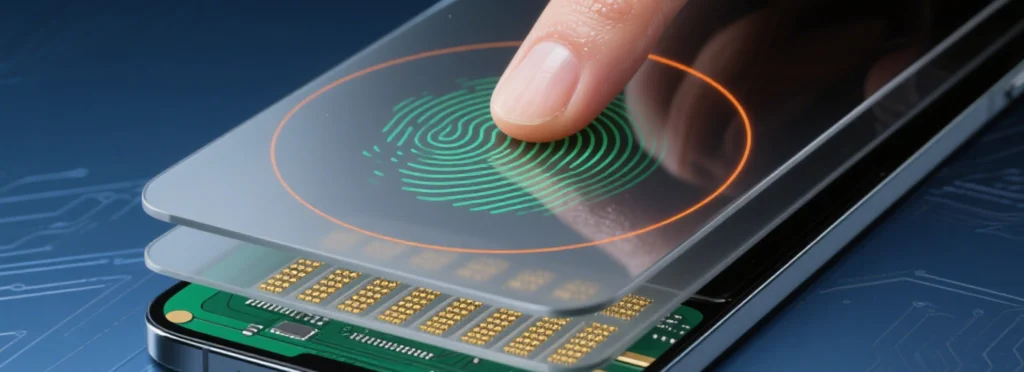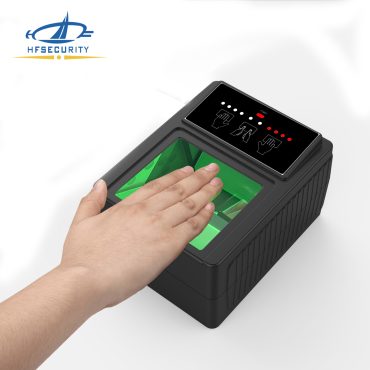This is the heading
1. Optical Fingerprint Scanners
An optical fingerprint scanner is a type of biometric device that captures a digital image of a fingerprint using light. When a finger is placed on the scanner surface, a light source—usually an LED—illuminates the finger. The reflected light is detected by a sensor, such as a charged-coupled device (CCD) or a complementary metal-oxide semiconductor (CMOS), which converts the fingerprint’s ridge and valley patterns into a digital image.
This digital image is then processed to create a unique fingerprint template, which can be used for identity verification, access control, or attendance management. Optical fingerprint scanners are widely used because of their reliability, ease of use, and affordability, making them a common choice in security systems and consumer electronics.
How Optical Fingerprint Scanners Work
When a finger is placed on the scanner surface, a light source illuminates the ridges and valleys of the fingerprint. A CCD or CMOS sensor captures the reflected light and creates a digital image of the fingerprint. This image is then compared to stored fingerprint templates for authentication.
Advantages of Optical Fingerprint Scanners
Cost-effective and widely available
Easy integration into laptops, smartphones, and access control systems
Some models offer non-contact scanning
Limitations of Optical Fingerprint Scanners
Performance can be affected by dust, dirt, or smudges
More susceptible to spoofing with fake fingerprints compared to capacitive or ultrasonic scanners
Applications of Optical Fingerprint Scanners
Optical fingerprint scanners are widely used across various industries and everyday devices due to their reliability and ease of use. Some of the most common applications include:
Laptop and Smartphone Fingerprint Authentication
Many modern laptops and smartphones integrate optical fingerprint scanners for user authentication. This allows users to unlock devices quickly and securely without relying on passwords or PINs. Optical scanners provide a convenient biometric solution for personal devices while ensuring data protection.Office and Building Access Control
In workplaces and secure facilities, optical fingerprint scanners are used in access control systems to regulate entry. Employees can gain access to restricted areas by simply placing their finger on the scanner, reducing the need for keycards or passwords. This enhances security, prevents unauthorized access, and simplifies attendance tracking.Public Kiosks and Self-Service Terminals
Public kiosks, such as banking ATMs, airport check-in counters, and government service terminals, often use optical fingerprint scanners to verify identity. These scanners ensure secure transactions, reduce fraud, and provide a seamless, user-friendly experience for individuals accessing self-service systems.Time and Attendance Systems
Many organizations deploy optical fingerprint scanners for timekeeping and attendance management. Employees can quickly clock in and out using their fingerprint, streamlining HR processes, improving accuracy, and minimizing buddy punching or attendance fraud.Healthcare and Patient Identification
Hospitals and clinics use optical fingerprint scanners to manage patient records securely. Scanning fingerprints ensures accurate identification, prevents duplicate records, and protects sensitive medical information.
By integrating optical fingerprint scanners into these applications, organizations and individuals benefit from enhanced security, convenience, and efficiency across multiple sectors.
2. Capacitive Fingerprint Scanners
A capacitive fingerprint scanner—also called a semiconductor fingerprint sensor—is a biometric reader that identifies a person by measuring tiny electrical charge differences created by fingerprint ridges and valleys. Instead of taking a photo (like an optical scanner), it builds an electrical map of your fingertip and converts that map into a digital template for fast, secure authentication. This technology is widely used in mobile fingerprint devices, time & attendance systems, and enterprise access control.
How Capacitive Fingerprint Scanners Work
When a finger touches the sensor, the capacitance changes between ridges and valleys are measured. These measurements are converted into a high-precision digital fingerprint template, which ensures accurate biometric authentication.
Advantages of Capacitive Fingerprint Scanners
High security and accuracy
Compact size suitable for smartphones and tablets
Resistant to fake fingerprints
Limitations of Capacitive Fingerprint Scanners
Requires direct skin contact
Wet or extremely dry fingers may reduce accuracy
Applications of Capacitive Fingerprint Scanners
Capacitive fingerprint scanners are widely adopted across industries due to their compact design, high accuracy, and strong anti-spoofing capabilities. Key applications include:
Mobile Device Fingerprint Authentication
Capacitive fingerprint sensors are the most common choice for smartphones and tablets, integrated into power buttons, home buttons, or under-display modules. They allow users to unlock devices, authorize app access, and secure personal data quickly and conveniently.Secure Banking and Payment Apps
Financial institutions and fintech companies use capacitive fingerprint scanners for secure logins and mobile payments. By verifying a user’s fingerprint, these scanners ensure that only authorized individuals can approve money transfers or access sensitive financial data.Enterprise Access Control and Security Systems
Many offices, data centers, and government buildings use capacitive fingerprint scanners in access control systems. They provide fast, reliable entry for employees while eliminating the risks associated with stolen keycards or forgotten passwords.Time and Attendance Management
Capacitive fingerprint scanners are integrated into biometric attendance systems, helping organizations track employee working hours accurately. They reduce “buddy punching” and improve overall HR efficiency.Point-of-Sale (POS) and Retail Terminals
Retailers and service providers integrate capacitive fingerprint authentication into POS machines for cashier logins, staff attendance, and even secure payment verification, enhancing transaction security.Healthcare and Patient Identification
Hospitals and clinics use capacitive fingerprint scanners to verify patient identities, ensure accurate medical record management, and restrict access to sensitive healthcare systems.Industrial and IoT Devices
Capacitive fingerprint sensors are increasingly embedded in IoT devices, smart locks, and industrial machinery. They provide compact, low-power, and secure biometric verification for both operators and end-users.
Ultrasonic Fingerprint Scanners
Ultrasonic fingerprint scanners are the latest innovation in biometric fingerprint scanning technology. They use high-frequency ultrasonic waves to map both the surface and subsurface features of a fingerprint, offering 3D fingerprint recognition and enhanced security against spoofing.

How Ultrasonic Fingerprint Scanners Work
The scanner emits ultrasonic pulses that penetrate the skin. The reflected echoes create a detailed 3D fingerprint map, including ridge patterns and pores. This allows highly accurate authentication and superior resistance to fake fingerprints.
Advantages of Ultrasonic Fingerprint Scanners
Extremely high security and accuracy
Can scan through dirt, oil, and moisture
Difficult to spoof or forge
Limitations of Ultrasonic Fingerprint Scanners
Higher cost compared to optical and capacitive scanners
Slightly slower recognition in some scenarios
Common Applications of Ultrasonic Fingerprint Scanners
Ultrasonic fingerprint scanners use high-frequency sound waves to capture detailed 3D fingerprint data, offering superior accuracy and anti-spoofing capabilities compared to optical and capacitive sensors. Because of their high security and ability to work even with wet or dirty fingers, they are widely used in advanced biometric applications. Common applications include:
Premium Smartphones and Tablets
Ultrasonic fingerprint scanners are integrated into flagship smartphones and tablets, often under the display. They provide fast and reliable biometric authentication, even if the screen or finger is slightly wet, making them a popular choice for high-end consumer electronics.Secure Mobile Payments and Banking
Financial institutions rely on ultrasonic fingerprint scanners for secure mobile payments, mobile banking apps, and digital wallets. Their 3D sensing technology offers a stronger defense against spoofing, ensuring that only legitimate users can authorize transactions.Government and Enterprise-Level Access Control
Government offices, military facilities, and large enterprises deploy ultrasonic fingerprint scanners in access control systems to protect highly sensitive areas. The scanners ensure precise identity verification, reducing risks of unauthorized entry.Healthcare and Patient Verification
Hospitals and medical centers use ultrasonic fingerprint scanners to securely identify patients, doctors, and staff. Because they capture deep fingerprint data, they are effective even in challenging conditions such as dry or damaged skin, ensuring accurate patient records and controlled access to sensitive data.Biometric Attendance Systems
Organizations with strict security needs integrate ultrasonic scanners into their time and attendance systems. They prevent fraud such as “buddy punching” while maintaining reliable performance in different environmental conditions.Banking Terminals and ATMs
Ultrasonic fingerprint scanners are used in ATMs and other financial service kiosks to strengthen transaction security. Their high resistance to spoofing makes them ideal for preventing identity theft and fraud in the banking industry.IoT Devices and Smart Home Security
Smart locks, connected devices, and IoT security solutions increasingly integrate ultrasonic fingerprint technology for homeowner authentication. The scanners provide reliable biometric protection in outdoor or variable environments where optical or capacitive sensors may fail.Law Enforcement and Border Security
Police departments, immigration services, and border control agencies deploy ultrasonic fingerprint scanners for accurate identity verification. Their ability to capture 3D ridge detail ensures higher matching accuracy for forensic and legal purposes.
Conclusion
Understanding the three types of fingerprint scanners—optical, capacitive, and ultrasonic—helps businesses and individuals select the right biometric security solution. Each type offers different levels of accuracy, convenience, and security, making it essential to choose a scanner based on your specific needs, whether for mobile devices, office access control, or high-security environments. Selecting the appropriate fingerprint scanner technology ensures a balance between security, usability, and cost-effectiveness.
Contact Us
We would love to speak with you.
Feel free to reach out using the below details.



